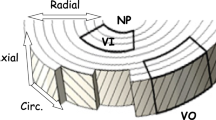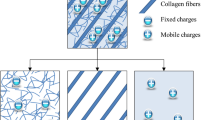Abstract
Loading of the spine induces dynamic changes in the osmotic environment of the intervertebral disc (IVD) due to the exudation and recovery of tissue water. Cells from the anulus fibrosus (AF) respond to osmotic stress with altered biosynthesis through a pathway that may involve calcium (Ca2+) as a second messenger. We examined the hypothesis that AF cells respond to hypo-osmotic stress by swelling and initiating regulatory volume decrease (RVD). Further, the role of F-actin disruption and transient increases in intracellular calcium concentration ([Ca2+] i ) in volume adaptation were studied. In response to hypo-osmotic stress, AF cells swelled, disrupted F-actin, and exhibited [Ca2+] i transients in proportion to the magnitude of the stress. The transient disruption of F-actin was dependent on the presence of extracellular Ca2+. After swelling, AF cells underwent RVD at all magnitudes of hypo-osmotic stress. The extent of RVD was diminished significantly by F-actin breakdown using cytochalasin D or by inhibition of swelling-induced F-actin disruption by removing extracellular Ca2+. Swelling-induced disruption of F-actin facilitated RVD, as evidenced by a more rapid volume recovery with increased F-actin breakdown. In conclusion, our findings suggest that the F-actin network plays an important role in the response of AF cells to osmotic stress.
Similar content being viewed by others
References
1Alexopoulos, L. G., G. R. Erickson, and F. Guilak. A method for quantifying cell size from differential interference contrast images: Validation and application to osmotically stressed chondrocytes. J. Microsc. 205:125-135, 2002.
2Antoniou, J., T. Steffen, F. Nelson, N. Winterbottom, A. P. Hollander, R. A. Poole, M. Aebi, and M. Alini. The human lumbar intervertebral disc: Evidence for changes in the biosynthesis and denaturation of the extracellular matrix with growth, maturation, ageing, and degeneration. J. Clin. Invest. 98:996-1003, 1996.
3Asada, S., K. Fukuda, F. Nishisaka, M. Matsukawa, and C. Hamanisi. Hydrogen peroxide induces apoptosis of chondrocytes; involvement of calcium ion and extracellular signal-regulated protein kinase. Inflamm. Res. 50:19-23, 2001.
4Baer, A. E., T. A. Laursen, F. Guilak, and L. A. Setton. The micromechanical environment of intervertebral disc cells determined by a finite deformation, anisotropic, and biphasic finite element model. J. Biomech. Eng. 125:1-11, 2003.
5Baer, A. E., and L. A. Setton. The micromechanical environment of intervertebral disc cells: Effect of matrix anisotropy and cell geometry predicted by a linear model. J. Biomech. Eng. 122:245-251, 2000.
6Baer, A. E., J. Y. Wang, V. B. Kraus, and L. A. Setton. Collagen gene expression and mechanical properties of intervertebral disc cell-alginate cultures. J. Orthop. Res. 19:2-10, 2001.
7Buckwalter, J. A. Aging and degeneration of the human intervertebral disc. Spine 20:1307-1314, 1995.
8Cantiello, H. F. Role of the actin cytoskeleton on epithelial Na+ channel regulation. Kidney Int. 48:970-984, 1995.
9Cantiello, H. F. Role of actin filament organization in cell volume and ion channel regulation. J. Exp. Zool. 279:425-435, 1997.
10Chen, J., A. E. Baer, P. Y. Paik, W. Yan, and L. A. Setton. Matrix protein gene expression in intervertebral disc cells subjected to altered osmolarity. Biochem. Biophys. Res. Commun. 293:932-938, 2002.
11Colliou, H. F. Matrix disorganization, apoptosis and gene expression in the intervertebral disc are modulated by compressive loading: A mouse model for disc degeneration. Trans. Orthop. Res. Soc. 23:189, 1998.
12Cornet, M., Y. Isobe, and L. F. Lemanski. Effects of anisosmotic conditions on the cytoskeletal architecture of cultured PC12 cells. J. Morphol. 222:269-286, 1994.
13Dascalu, A., R. Korenstein, Y. Oron, and Z. Nevo. A hyperosmotic stimulus regulates intracellular pH, calcium, and S-100 protein levels in avian chondrocytes. Biochem. Biophys. Res. Commun. 227:368-373, 1996.
14Dascalu, A., A. Matithyou, Y. Oron, and R. Korenstein. A hyperosmotic stimulus elevates intracellular calcium and inhibits proliferation of a human keratinocyte cell line. J. Invest. Dermatol. 115:714-718, 2000.
15Erickson, G. R., L. G. Alexopoulos, and F. Guilak. Hyper-osmotic stress induces volume change and calcium transients in chondrocytes by transmembrane, phospholipid, and G-protein pathways. J. Biomech. 34:1527-1535, 2001.
16Erickson, G. R., D. L. Northrup, and F. Guilak. Hypo-osmotic stress induces calcium-dependent actin reorganization in articular chondrocytes. Osteoarthritis Cartilage 11:187-197, 2003.
17Gual, P., S. Shigematsu, M. Kanzaki, T. Gremeaux, T. Gonzalez, J. E. Pessin, Y. LeMarchand-Brustel, and J. F. Tanti. A Crk-II/TC10 signaling pathway is required for osmotic shock-stimulated glucose transport. J. Biol. Chem. 277:43980-43986, 2002.
18Guilak, F., G. R. Erickson, and H. P. Ting-Beall. The effects of osmotic stress on the viscoelastic and physical properties of articular chondrocytes. Biophys. J. 82:720-727, 2002.
19Guilak, F., H. P. Ting-Beall, A. E. Baer, W. R. Trickey, G. R. Erickson, and L. A. Setton. Viscoelastic properties of intervertebral disc cells. Identification of two biomechanically distinct cell populations. Spine 24:2475-2483, 1999.
20Guizouarn, H., R. Motais, F. Garcia-Romeu, and F. Borgese. Cell volume regulation: The role of taurine loss in maintaining membrane potential and cell pH. J. Physiol. 523(Pt. 1):147-154, 2000.
21Hallows, K. R., F. Y. Law, C. H. Packman, and P. A. Knauf. Changes in cytoskeletal actin content, F-actin distribution, and surface morphology during HL-60 cell volume regulation. J. Cell Physiol. 167:60-71, 1996.
22Hardingham, G. E., and H. Bading. Calcium as a versatile second messenger in the control of gene expression. Microsc. Res. Tech. 46:348-355, 1999.
23Henson, J. H. Relationships between the actin cytoskeleton and cell volume regulation. Microsc. Res. Tech. 47:155-162, 1999.
24Hildebrandt, J. P., and A. Prowald. Ca(2+) and p38 MAP kinase regulate mAChR-mediated c-Fos expression in avian exocrine cells. Am. J. Physiol. Cell. Physiol. 278:C879-884, 2000.
25Hutton, W. C., T. M. Ganey, W. A. Elmer, E. Kozlowska, J. L. Ugbo, E. S. Doh, and T. E. Whitesides. Does long-term compressive loading on the intervertebral disc cause degeneration? Spine 25:2993-3004, 2000.
26Hutton, W. C., Y. Toribatake, W. A. Elmer, T. M. Ganey, K. Tomita, and T. E. Whitesides. The effect of compressive force applied to the intervertebral disc in vivo. A study of proteoglycans and collagen. Spine 23:2524-2537, 1998.
27Iatridis, J. C., P. L. Mente, I. A. Stokes, D. D. Aronsson, and M. Alini. Compression-induced changes in intervertebral disc properties in a rat tail model. Spine 24:996-1002, 1999.
28Ingber, D. E., L. Dike, L. Hansen, S. Karp, H. Liley, A. Maniotis, H. McNamee, D. Mooney, G. Plopper, and J. Sims. Cellular tensegrity: Exploring how mechanical changes in the cytoskeleton regulate cell growth, migration, and tissue pattern during morphogenesis. Int. Rev. Cytol. 150:173-224, 1994.
29Ishihara, H., K. Warensjo, S. Roberts, and J. P. Urban. Proteoglycan synthesis in the intervertebral disk nucleus:The role of extracellular osmolality. Am. J. Physiol. 272:C1499-C1506, 1997.
30Janmey, P. A. The cytoskeleton and cell signaling: Component localization and mechanical coupling. Physiol. Rev. 78:763-781, 1998.
31Kajstura, J., and K. Reiss. F-actin organization influences the osmotic reactions of animal cells. Folia Histochem. Cytobiol. 27:201-208, 1989.
32Kanzaki, M., and J. E. Pessin. Insulin-stimulated GLUT4 translocation in adipocytes is dependent upon cortical actin remodeling. J. Biol. Chem. 276:42436-42444, 2001.
33Kinosian, H. J., L. A. Selden, J. E. Estes, and L. C. Gershman. Actin filament annealing in the presence of ATP and phalloidin. Biochemistry 32:12353-12357, 1993.
34Lang, F., G. L. Busch, and H. Volkl. The diversity of volume regulatory mechanisms. Cell Physiol. Biochem. 8:1-45, 1998.
35Lange, K. Microvillar Ca++ signaling: A new view of an old problem. J. Cell. Physiol. 180:19-34, 1999.
36Lange, K. Regulation of cell volume via microvillar ion channels. J. Cell. Physiol. 185:21-35, 2000.
37Le Bihan, T., and C. Gicquaud. Stabilization of actin by phalloidin: A differential scanning calorimetric study. Biochem. Biophys. Res. Commun. 181:542-547, 1991.
38Maldonado, B. A., and T. R. Oegema. Initial characterization of the metabolism of intervertebral disc cells encapsulated in microspheres. J. Orthop. Res. 10:677-690, 1992.
39Malko, J. A., W. C. Hutton, and W. A. Fajman. An in vivo magnetic resonance imaging study of changes in the volume (and fluid content) of the lumbar intervertebral discs during a simulated diurnal load cycle. Spine 24:1015-1022, 1999.
40McCarty, N. A., and R. G. O'Neil. Calcium signaling in cell volume regulation. Physiol. Rev. 72:1037-1061, 1992.
41McMillan, D. W., G. Garbutt, and M. A. Adams. Effect of sustained loading on the water content of intervertebral discs: Implications for disc metabolism. Ann. Rheum. Dis. 55:880-887, 1996.
42Mills, J. W., E. M. Schwiebert, and B. A. Stanton. The cytoskeleton and membrane transport. Curr. Opin. Nephrol. Hypertens. 3:529-534, 1994.
43Moran, J., M. Sabanero, I. Meza, and H. Pasantes-Morales. Changes of actin cytoskeleton during swelling and regulatory volume decrease in cultured astrocytes. Am. J. Physiol. 271:C1901-C1907, 1996.
44Oegema, T. R. Biochemistry of the intervertebral disc. Clin. Sports Med. 12:419-439, 1993.
45Ohshima, H., H. Tsuji, N. Hirano, H. Ishihara, Y. Katoh, and H. Yamada. Water diffusion pathway, swelling pressure, and biomechanical properties of the intervertebral disc during compression load. Spine 14:1234-1244, 1989.
46Ohshima, H., J. P. Urban, and D. H. Bergel. Effect of static load on matrix synthesis rates in the intervertebral disc measured in vitro by a new perfusion technique. J. Orthop. Res. 13:22-29, 1995.
47O'Neill, W. C. Physiological significance of volume-regulatory transporters. Am. J. Physiol. 276:C995-C1011, 1999.
48Paajanen, H., I. Lehto, A. Alanen, M. Erkintalo, and M. Komu. Diurnal fluid changes of lumbar discs measured indirectly by magnetic resonance imaging. J. Orthop. Res. 12:509-514, 1994.
49Perlman, D. F., and L. Goldstein. Organic osmolyte channels in cell volume regulation in vertebrates. J. Exp. Zool. 283:725-733, 1999.
50Petrov, A. G., and P. N. Usherwood. Mechanosensitivity of cell membranes. Ion channels, lipid matrix and cytoskeleton. Eur. Biophys. J. 23:1-19, 1994.
51Pritchard, S., G. R. Erickson, and F. Guilak. Hyperosmotically induced volume change and calcium signaling in intervertebral disk cells: The role of the actin cytoskeleton. Biophys. J. 83:2502-2510, 2002.
52Rivero, F., B. Koppel, B. Peracino, S. Bozzaro, F. Siegert, C. J. Weijer, M. Schleicher, R. Albrecht, and A. A. Noegel. The role of the cortical cytoskeleton: F-actin crosslinking proteins protect against osmotic stress, ensure cell size, cell shape and motility, and contribute to phagocytosis and development. J. Cell. Sci. 109(Pt. 11):2679-2691, 1996.
53Schliess, F., R. Sinning, R. Fischer, C. Schmalenbach, and D. Haussinger. Calcium-dependent activation of Erk-1 and Erk-2 after hypo-osmotic astrocyte swelling. Biochem. J. 320(Pt. 1):167-171, 1996.
54Schliwa, M. Action of cytochalasin D on cytoskeletal networks. J. Cell. Biol. 92:79-91, 1982.
55Sheikh, S., W. B. Gratzer, J. C. Pinder, and G. B. Nash. Actin polymerisation regulates integrin-mediated adhesion as well as rigidity of neutrophils. Biochem. Biophys. Res. Commun. 238:910-915, 1997.
56Sullivan, E., E. M. Tucker, and I. L. Dale. Measurement of [Ca2+] using the Fluorometric Imaging Plate Reader (FLIPR). Methods Mol. Biol. 114:125-133, 1999.
57Trickey, W. R., T. Vail, T. Wright, and F. Guilak. The role of the cytoskeleton in the viscoelastic properties of osteoarthritic human chondrocytes. Trans. Orthop. Res. Soc. 25:930, 2000.
58Tseng, Y., E. Fedorov, J. M. McCaffery, S. C. Almo, and D. Wirtz. Micromechanics and ultrastructure of actin filament networks crosslinked by human fascin: A comparison with alpha-actinin. J. Mol. Biol. 310:351-366, 2001.
59Urban, J. P., H. Ishihara, and M. J. Mouat. Differential metabolic responses of the nucleus and outer anulus to changes in extracellular physical factors. Trans. Orthop. Res. Soc. 19:134, 1994.
60Verkman, A. S., A. N. van Hoek, T. Ma, A. Frigeri, W. R. Skach, A. Mitra, B. K. Tamarappoo, and J. Farinas. Water transport across mammalian cell membranes. Am. J. Physiol. 270:C12-C30, 1996.
61Waldegger, S., S. Steuer, T. Risler, A. Heidland, G. Capasso, S. Massry, and F. Lang. Mechanisms and clinical significance of cell volume regulation. Nephrol. Dial. Transplant. 13:867-874, 1998.
62Wang, N. Mechanical interactions among cytoskeletal filaments. Hypertension 32:162-165, 1998.
63Wendel, H., and P. Dancker. Influence of phalloidin on both the nucleation and the elongation phase of actin polymerization. Biochim. Biophys. Acta 915:199-204, 1987.
64Yin, H. L., J. H. Albrecht, and A. Fattoum. Identification of gelsolin, a Ca2+-dependent regulatory protein of actin gel–sol transformation, and its intracellular distribution in a variety of cells and tissues. J. Cell. Biol. 91:901-906, 1981.
65Yin, H. L., and T. P. Stossel. Control of cytoplasmic actin gel–sol transformation by gelsolin, a calcium-dependent regulatory protein. Nature 281:583-586, 1979.
Author information
Authors and Affiliations
Rights and permissions
About this article
Cite this article
Pritchard, S., Guilak, F. The Role of F-Actin in Hypo-Osmotically Induced Cell Volume Change and Calcium Signaling in Anulus Fibrosus Cells. Annals of Biomedical Engineering 32, 103–111 (2004). https://doi.org/10.1023/B:ABME.0000007795.69001.35
Issue Date:
DOI: https://doi.org/10.1023/B:ABME.0000007795.69001.35




